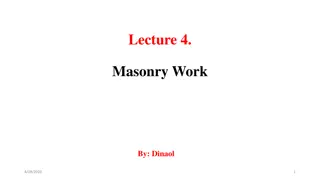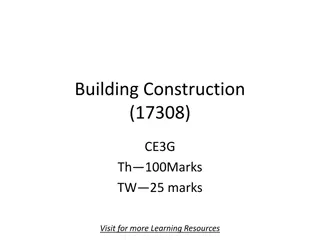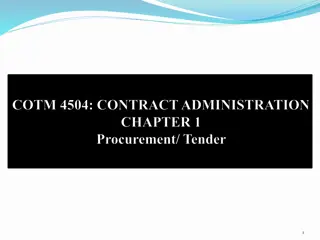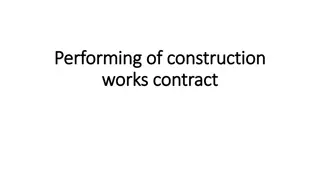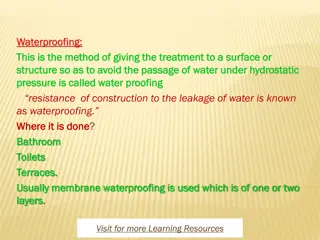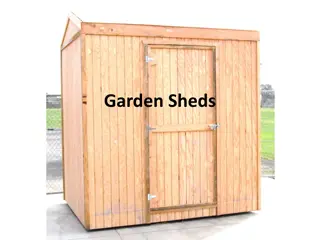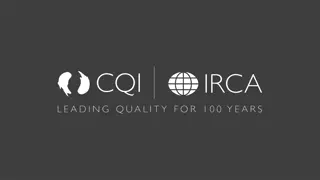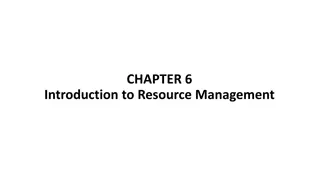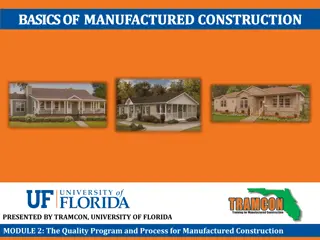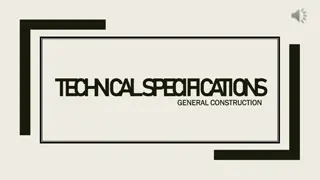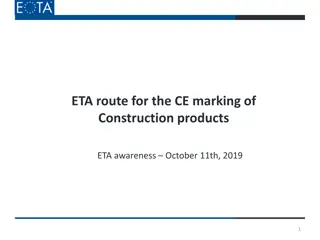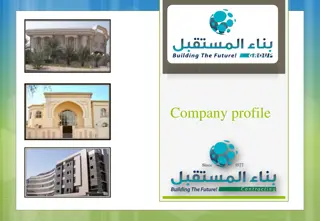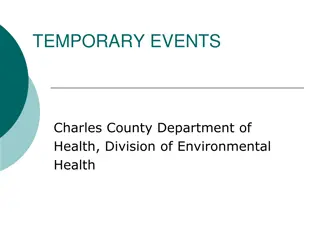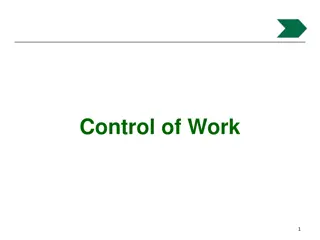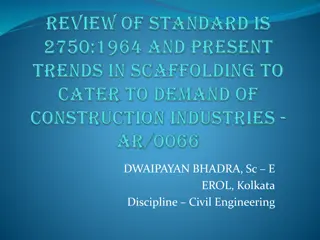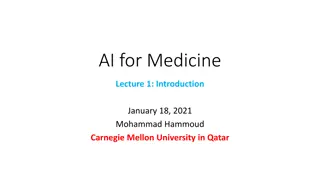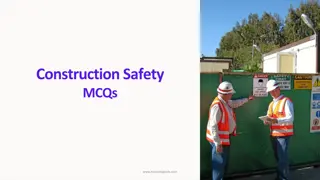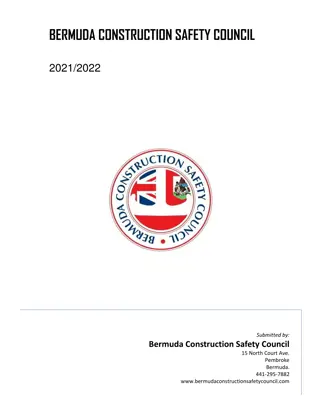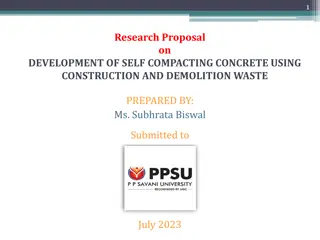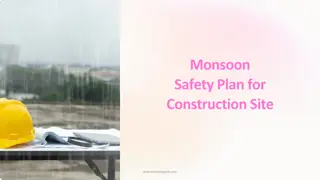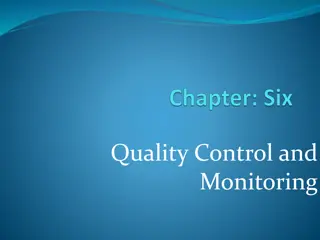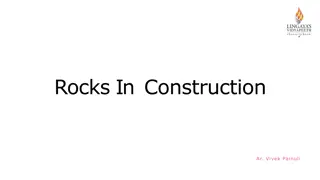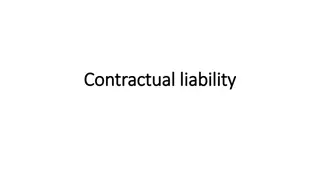Introduction to Plumbing Work and Tools: Sanitary Construction Lecture
Plumbing involves the installation and maintenance of piping, fixtures, and appliances for water supply and wastewater systems. This lecture covers the principles, materials, tools, and techniques essential for safe sewage collection and water supply. Importance is placed on the close relationship between plumbing systems and public health due to potential health hazards posed by contaminated water supplies. Various plumbing tools for measuring and work are discussed in detail.
Download Presentation

Please find below an Image/Link to download the presentation.
The content on the website is provided AS IS for your information and personal use only. It may not be sold, licensed, or shared on other websites without obtaining consent from the author. Download presentation by click this link. If you encounter any issues during the download, it is possible that the publisher has removed the file from their server.
E N D
Presentation Transcript
Lecture 3. Plumbing By: Dinaol Sanitary Construction Lecture 3. 1
In this Lecture Introduction to plumbing work Plumbing hand tools and Materials Plumbing fixtures and their installations Sanitary Construction Lecture 3. 2
3.1 Introduction Plumbing includes the practice, materials and fixtures used in the installation, maintenance, extension, and alteration of all piping, fixtures, appliance, and all appurtenances in connection with any of the following: Sanitary drainage or storm drainage facilities, the venting systems and the private water supply systems, within or adjacent to any building, structure or conveyance; and the practice and materials used in the installation, maintenance, extension, of the storm water, liquid waste and the water supply system of any premises to their connection with any point of public disposal or other acceptable terminal. Sanitary Construction Lecture 3. 3
3.1 Introduction Plumbing can be categorized into two main classes: water supply and wastewater plumbing. These categories have their own principles, materials, tools and related techniques to deliver water or to dispose the by-product to appropriate places in a sanitary manner. Sanitary Construction Lecture 3. 4
3.1 Introduction The importance of safe methods of sewage collection, and disposal, and provision of safe water supply are realized by all sanitarians. One of the links of this chain is the house drainage system, in other words, the plumbing system. Its importance is enhanced by the fact that it is in far closer contact with everyday life of the citizen than is the common sewer or sewage treatment plant. The sewage, which the plumbing system carries, is potentially dangerous in that it frequently contains disease-producing bacteria. Leakage in plumbing systems, therefore, is a means to health in the house where well water supplies may be contaminated Sanitary Construction Lecture 3. 5
3.2 Plumbing Tools and Materials A. Plumbing Tools 1. Plumbing tools for measuring: Marking pen Plumb level Sprit level Flange square Fold meter Caliper Tape meter Sanitary Construction Lecture 3. 6
A. Plumbing Tools 2. Plumbing tools for threading: Threading die Die stock from 3/8 to 1 Internal threading tools Adjustable threading tools Sanitary Construction Lecture 3. 7
A. Plumbing Tools 3. Plumbing tools for cutting: Steel pipe cutter Chain cutter Sharp chisel Hacksaw Holesaw Reamer Sanitary Construction Lecture 3. 8
A. Plumbing Tools 4. Plumbing tools for bending: Bending machines Bending spring Sanitary Construction Lecture 3. 9
A. Plumbing Tools 5. Plumbing tools for drilling: The BI hand driving machine Manual hand driving machine Brick chisel Concrete chisel Sanitary Construction Lecture 3. 10
A. Plumbing Tools 6. Other instruments for plumbing work: Adjustable spanner Adjustable wrench Chain wrench Pipe vise Sanitary Construction Lecture 3. 11
B. Plumbing Materials 1) Pipes Pipes used for rural and urban water supply and wastewater disposal projects are pressure pipes, and are usually manufactured from plastics, galvanized steel or asbestos, cement and copper pipes. Each material has particular advantages and disadvantages. When two or more materials are suitable for a given situation, the selection will be based on cost. Sanitary Construction Lecture 3. 12
B. Plumbing Materials Choice of pipe materials depends on: 1. Required strength 2. Corrosion resistance 3. Erosion resistance 4. Roughness factors 5. Cost effectiveness Sanitary Construction Lecture 3. 13
B. Plumbing Materials Kinds of pipes used for water supply system 1. Steel pipes It is the most common employed pipe, normally connected to fittings by threaded joints. It is manufactured in 21-ft length and the fittings are factory threaded. Screwing pipe and fittings together makes joints. The steel pipe is the strongest pipe and the most rigid of the piping materials. Its cost is low, easily maintainable, easily portable, and a wide range of sizes are available. Sanitary Construction Lecture 3. 14
B. Plumbing Materials 2. Plastic pipes: For most projects it will be found that plastic pipe will prove the most suitable. While there are a number of different types of plastic pipe, rigid PVC is the most commonly used, though high density polyethylene is frequently used when long lengths of small diameter pipe are required. Sanitary Construction Lecture 3. 15
B. Plumbing Materials Apart from being highly competitive in purchase price, its extreme lightness makes site handling easier and, once laid, it presents no problems of corrosion or encrustations. A further advantage is that, due to its low friction losses, it is usually possible to use PVC pipes one size smaller than a metal pipe for the same flow and head loss conditions. Sanitary Construction Lecture 3. 16
Major Advantages and Disadvantages of Plastic Pipes. Advantages 1. Low costs, capital, transport and laying 2. Lowest friction loss of all water pipe material 3. Non-corrosive 4. Non-toxic 5. Good insulation 6. Low thermal conductivity 7. Rapid and simple jointing 8. Good for laying under water 9. Flexible 10. Extremely light and easy to handle Sanitary Construction Lecture 3. 17
Major Advantages and Disadvantages of Plastic Pipes. Disadvantages 1. Brittle at certain temperatures 2. Loss of strength at high temperature 3. Not suitable for laying above ground 4. Requires ample ground cover to avoid damage 5. Can deform during storage Sanitary Construction Lecture 3. 18
B. Plumbing Materials Copper tubing It is the most expensive material used for the transportation of water and gases. It is non-corrosive with most water and used extensively in better grade houses. Also used where ground water is highly corrosive to well pipes. Sanitary Construction Lecture 3. 19
B. Plumbing Materials Galvanized steel pipe It is important to install under heavy loads, exposed as on bridges and lines under pressure. Pipe sizes are usually expressed as nominal diameter (in inches). The sizes normally used for small water supplies are , , 1 , 1 , 1 , 2 , 2 1/2 and 3 . Galvanized steel pipes are jointed by means of sockets; the pipe has a toper thread while the socket has parallel thread. Most pipes are zinc galvanized. However, ungalvanized or black pipe is available (primarily as well casing). Pipes are usually welded. These are somewhat cheaper than seamless pipes, and the former are entirely suitable for small community water supplies. Sanitary Construction Lecture 3. 20
Major Advantages and Disadvantages of Galvanized Steel Pipes Advantages 1. Robust but may bend 2. Easy to lay and joint 3. May be laid to above ground 4. Generally unaffected by climatic conditions 5. Fittings inexpensive extremes Sanitary Construction Lecture 3. 21
Major Advantages and Disadvantages of Galvanized Steel Pipes Disadvantages 1. Liable to internal and external corrosion 2. Liable to incrustation 3. Higher friction head losses 4. Relatively high cost of purchase 5. Relatively high cost of transport Sanitary Construction Lecture 3. 22
B. Plumbing Materials Asbestos - cement pipes pipe comes in greater length, therefore has fewer joints; it has a smooth surface, is noncorrosive and easily jointed, and resistant to electric current and concentrated salts. The more common joint is asbestos cement sleeve joint incorporating two rubber rings. Sanitary Construction Lecture 3. 23
Major Advantages and Disadvantages of Asbestos - Cement Pipes Advantages 1. Durability (known to exceed 50 years) 2. Immunity from corrosion 3. Low friction (low head loss) 4. Good thermal insulation 5. Lighter and cheaper than metal pipe Disadvantages 1. Liable to damage in transit. 2. Not suitable for laying above ground or in rocky ground 3. Supplied in relatively short lengths, hence more joints 4. Asbestos can be very hazardous to your health Sanitary Construction Lecture 3. 24
2. Fittings in water supply Fittings in water supply are devices used to connect or bend or reduce/ enlarge or close pipes that serve different purposes. Cap: A fitting into which the end of a pipe is screwed for the purpose of closing the end of the pipe. Coupling: A pipe fitting with inside threads only used for connecting two pipes. Elbow: A fitting joining two pipes at an angle. Plug: A pipe fitting with outside thread and projecting head, often square, that is used for closing the opening in another fitting. Sanitary Construction Lecture 3. 25
2. Fittings in water supply Reducer: A pipe fitting with inside threads, larger at one end than at the other. All such fittings having more than one size are reducers because of the custom of stating the larger size first. Trap: A fitting constructed with a water seal that, when placed in a drainage pipe, will prevent the passage of air or gas through the drainage pipe but will not prevent the flow of liquids through it. Sanitary Construction Lecture 3. 26
2. Fittings in water supply Union: A fitting used for joining the ends of two pipes neither of which can be turned. There are two kinds of unions. Tee: An internally threaded fitting that is used to distribute pipes with a "T mode. Cross Tee: an internal threaded tee that is used for distributing pipes across the four sides by making an angle of 900. Sanitary Construction Lecture 3. 27
2. Fittings in water supply Nipple: a short piece of pipe with outside threads used for connecting pipes or fittings in threaded joints. Y- branch: an internally threaded fitting used to distribute a pipe in a Y shaped mode. Sanitary Construction Lecture 3. 28
3. 3 Drainage and Sewerage Line System A prerequisite to sound design of a distribution system is a complete survey covering all streets and showing elevation of all-important points. From this survey, a map is prepared on a scale to show streams, important geographical features and adjacent areas likely to require services during the design period, and proposed as well as present streets. With the aid of this map, the principle features of the system can be planned. These maps also show the exact locations of the pipes in the streets. Sanitary Construction Lecture 3. 29
A. Some Appurtenances in Sewerage System Manhole: It is important when there is: change in direction. change of size of diameter pipes. a junction. a need of cleansing. a need for inspection Sanitary Construction Lecture 3. 30
A. Some Appurtenances in Sewerage System Manholes should be placed at distances of not more than 110m on long straight lengths. This distance may be increased in the case of large sized sewers. The reason is for maintenance and installation. In addition these requirements are primarily to facilitate rodding when blockages occur. Sometimes, it is believed that 110m is too large for small diameter pipes and one should provide manholes at 80m intervals on straight lengths. Sanitary Construction Lecture 3. 31
A. Some Appurtenances in Sewerage System Waste pipes There are different pipes that can be used for the conveyance of wastewater from the source of generation to the final disposal site. Some of the common types are: Sanitary Construction Lecture 3. 32
Waste pipes 1. Concrete pipe For small and medium size sewers, up to 24 in diameter, the use of non-reinforced concrete pipe is generally economical. If it is properly manufactured, it is highly resistant to weathering, chemicals (except acids) and wear. Acids should in general be kept out of sewers or neutralized. Sanitary Construction Lecture 3. 33
Waste pipes 2. Cast iron pipe It has a long life span, provide good flow characteristics, has the ability to withstand high internal pressures and external loads, and is corrosion resistant in most soils. Sanitary Construction Lecture 3. 34
Waste pipes 3. Plastic pipe It is rapidly increasing in popularity because of its light weight, and ease of handling and assembly. Although such pipe is becoming widely available, its uncertain life tends to prevent its widespread use for sewers. It is also free from corrosion, has good resistance to shock, acids and sunlight or bad weather, has flexibility, etc. Sanitary Construction Lecture 3. 35
Waste pipes 4. Asbestoses- cement pipes These pipes are highly subjected to corrosion. However, they are low in cost, watertight, have low infiltration, and good flow characteristics, and are lightweight and easy to handle and cut. Sanitary Construction Lecture 3. 36
B. Construction of sewer pipe Inspection is perhaps the most important part of sewer construction. The pipe is generally tested under inspection and marked before delivery to the job. Aside from quality of the finished products there are other important reasons: For close inspection safety To control pollution of groundwater To know the foundation is adequate Concrete support is the best support for sewer pipes where good natural foundation does not exists. What goes around and over the sewer pipe is as important as the support under it. Back filling is a vital operation. Fill should be placed and tamped equally and carefully on each side to at least 2 ft above the top of sewer. Sanitary Construction Lecture 3. 37
B. Construction of sewer pipe Vent pipes: are installed to provide a flow of air to or from a drainage system (pit). It also provides circulation of air within such a system to protect traps of backpressure. The various types of materials that are used for vent pipes are: PVC tubing Masonry works Plane sheet metals Sanitary Construction Lecture 3. 38
B. Construction of sewer pipe Size of pipes depends on: The size of waste Number of fixtures Number of closets connected. Smaller diameter pipes are prohibited because it may restrict venting action. The vent size should not less than 1 inches in diameter. Sanitary Construction Lecture 3. 39
Fixture: is a receptacle attached to a plumbing system other than a trap in which water or wastes can be collected or retained for use and for proper discharge into the drains. 1. Water closet (W.C.): The water closet, popularly known in its abbreviated form the W.C., is a device for depositing human wastes directly into a properly designed bowl or pan. Then the excreta are immediately carried away by water, which is flushed under pressure. These pans are designed in connection with flushing water under pressure. Sanitary Construction Lecture 3. 40
Fixture: 2. Flushing cistern: The flushing cistern attachment is designed to release a predetermined quantity of water under pressure in order to flush away excreta from W.C. pans or urinals. Sanitary Construction Lecture 3. 41
Fixture: 3. Lavatory: is a fixture designed for the washing of the hands and face, sometimes called a washbasin. These, like other sanitary fittings, are designed in a standard form and various makes are found on the market. They are usually made of glazed earthenware or porcelain. At the bottom they are connected to the wastewater discharge pipe. Since the room containing the washbasin often contains a W.C., the lavatory is often called the W.C. Sanitary Construction Lecture 3. 42
Fixture: 4. Bathtub and shower: A modern bathroom is provided with a bathtub and/or a shower for washing the body. Here again the bath is designed in a standard form and shape. A typical bath is oval-shaped, made of glazed earthenware or enameled cast iron. It is provided with a discharge hole controlled by a stopper or plug and chain, and fitted with an overflow device, in case the water is accidentally left flowing into the bath. Hot and cold water faucets or taps are fitted for filling the tub. Showers may be installed together with the bathtub or separately. Sanitary Construction Lecture 3. 43
Fixture: 5. Bidet: A bidet is an oval-shaped sitting-pan provided in some houses and fashionable hotels by the side of the W.C. and bathtubs. The bidet is not an essential component of bathroom fittings. It is provided for the purpose of intimate washing, especially for women. It is furnished with hot and cold water, and can produce an upward spray as desired. Sanitary Construction Lecture 3. 44
Fixture: 6. Sink: Sinks are large basins permanently installed in kitchens for washing dishes, pans, etc., and for cleaning vegetables, etc. Sinks are provided with stoppers for keeping water in them, and with an overflow device. They are connected through traps to the wastewater discharge pipes. Sanitary Construction Lecture 3. 45
Fixture: Another sanitary fitting commonly found in a modern house is the laundry facility, for washing clothes. It is usually a large sink, or two large sinks side by side, for washing and rinsing out soap. Sanitary Construction Lecture 3. 46
Fixture: Traps: A Trap is a device or fitting so designed and constructed as to provide a filter when properly vented. A liquid seal will prevent the back passage of air without materially affecting the flow of sewage or wastewater through it. Trap seal is the maximum vertical depth of liquid that a trap will retain. It should have one clean-out hole. It is used to prevent passage of sewer gas into the house system. Sanitary Construction Lecture 3. 47
Fixture: Valves The various types of valves likely to be used in different rural water supply projects are briefly described below. As these particular items are relatively expensive, care is needed in their selection. Sanitary Construction Lecture 3. 48
Fixture: A. Gate Valves The gate valve (or sluice valve) is used to cut off flows in pipelines by lowering a solid-type wedge "gate"; during normal operation unrestricted straight-through flow is achieved as the "gate" is raised inside the valve body (referred to as the bonnet), so that the bore of the pipe is completely clear. Sanitary Construction Lecture 3. 49
Fixture: B. Butterfly Valves The butterfly valve performs a function similar to that of the gate valve; its principle of operation is the turning of the disc through 90 degree to permit water to pass. The claimed advantages over the gate valve are lightness, greater speed of operation, low-pressure drop and low maintenance. Minimum size is 2" (50 mm). Sanitary Construction Lecture 3. 50



